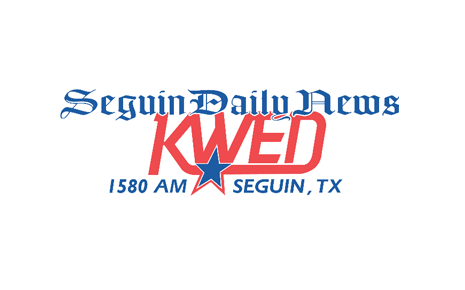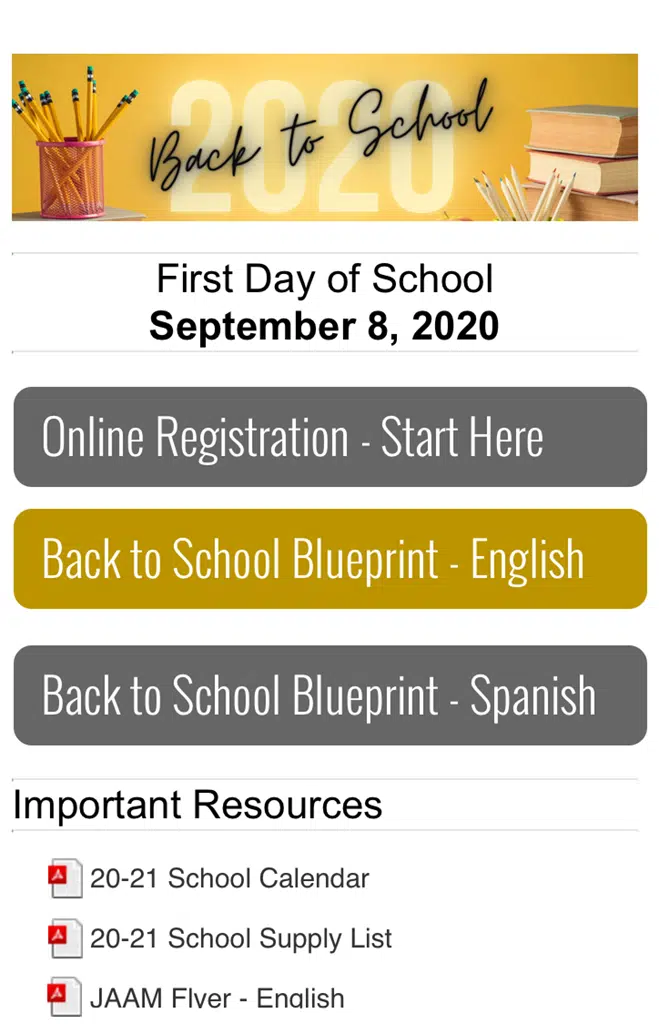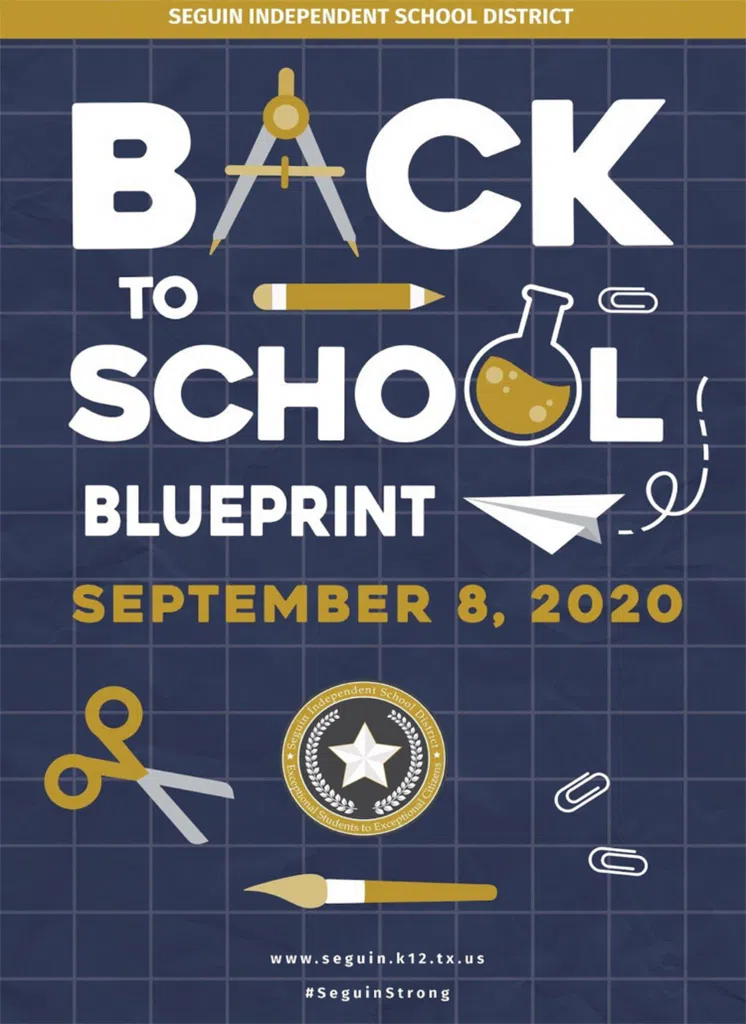Seguin ISD shares latest changes in Back to School protocols

28 Aug 2020
news, Seguin ISD, Covid19
(Seguin) — The Seguin ISD is outlining a few of its latest changes in how it hopes to welcome back students this coming school year.
As the first day of school fast approaches, the school district is doing its part to help families better prepare for what will be expected, especially if their child will be returning to the classroom.
Seguin ISD Chief Academic Officer Mark Cantu shared some of the changes and updates to the protocols during Tuesday’s meeting of the Seguin ISD Board of Trustees.
Cantu says although these changes have been outlined in red in the district’s Back to School Blueprint, he wanted to publicly share them in hopes of also explaining how future changes will continue to be highlighted in the 50 plus page document that has been outfitted specifically for Seguin ISD students.
Cantu says while the Blueprint establishes the operation of a campus for next school year, he reminds parents that things are expected to continuously change. So keeping up with the Blueprint is vital.
With that being said, the first change announced by Cantu can be found on page 21 of the Blueprint document currently available on the district’s website. The change pertains to isolation protocols – protocols Cantu says will be taken should the campus suspect that the child is infected with the COVID-19 virus.
“So, one of the first changes is on isolation protocols and that’s the first change on here. You’ll notice that any of the changes are marked in red and so if you notice something in red that means that we updated that. The first one, again, is on isolation protocols and you can see there towards the the bottom of the page some of the red items that we added. So this one, for example, says nurses will use clinical judgment to determine the symptoms presented — meet the school exclusion criteria. That’s on isolation protocols on page 21,” said Cantu.
Also added to the isolation protocols, is “separated students will be six feet apart from others and wear a mask waiting to be picked up. If the nurse station has a curtain to separate patients, it will be used. The students will be monitored by the nurse. Campuses can maintain an Isolation area if possible, considering space and ability to monitor.”
“The next update is on mask policy. As we just heard, anytime we hear new information or information that will keep us safer, we are going to add it in there. So one of them there is mask material must be at least two layers. So, we just want to add a little bit more clarity on what that looks like,” said Cantu.
Many of the changes at this time, also involve protocols in regards to lunch time. Helping to shed light on the process this coming fall were Tony Hillberg, chief financial officer and Kirsten Legore, deputy chief operations officer.
Hillberg helped to provide more clarity about breakfast and lunch. Hillberg says the district is doing what it can to ensure safety during this time of day.
“This has been like many things — a little bit of an evolution of thinking and understanding and sometimes when you come to an understanding, you realize, well why didn’t we think of that all along? Initially, the plan was to have all the meals served in the classroom and not bring the congregated groups into the cafeteria. However, the problem is once you take the masks off, then social distancing becomes that much more important and that’s going to be necessary wherever you are eating. So, there was a revision made to the master schedule at all of the elementary campuses and they are going to serve lunch for each grade level and by doing that, they are able to minimize the number of students congregating in the cafeteria at any lunch. So, the lunches are going to be served at the elementariness in the cafeteria by grade level,” said Hillberg.
Cantu adds that everyday, the district is working more and more to fine tune protocols for its daily meals.
“The idea is we will have a lunch period for every single grade level ranging between 20 and 25 minutes which is plenty of time for an elementary school student to eat and so that they can go out for recess if the time allows but that will also give us just enough time to be able to clean all the areas for the next grade level to come in. So, it’s really tight but we believe that instead of having the three lunch periods the way we usually do, the five lunch periods will serve the students better. Breakfast is in the classroom and that starts at 7:45 (a.m.),” said Cantu.
Now, Legore says that once they are ready to eat, students will also be required to wear a face shield.
“Depending on the local level so this is kind of an evolving matrix but where we are right now, kids will actually have face shields so they can remove their masks, keep their face shield on and eat breakfast. We feel like that made the classroom environment safer. The goal was also to maintain social distancing but until, we know how many students are in each individual classroom, that may not be possible in all the classrooms to maintain that six foot social distancing. So, the face shield as TEA puts it is a mitigated factor so as many mitigating factors that you can put in play, so masks and the face shields and hand sanitizer and all these things going on — the goal is to keep COVID from spreading. So lunch room then is where they will go at lunchtime and depending on whether or not you can social distance, we can also at the elementary school use face shields again. So, we have all tried. We have practiced eating with face shields. It is very doable and it just keeps people safer than just having them eat with nothing,” said Legore.
Legore says that face shields will be purchased and provided for each elementary school student only. She says social distancing is a little easier to provide at the secondary level.
 “Secondary schools just look at little different and you can use more spaces for lunch so like at the high school with the library and other open areas and then at the elementary schools with some of the large spaces of fine arts and athletics and what not — looking at how you can expand lunch areas. So that’s what they looked for there. The reason is face shields with elementary students can be given a spot in the room and the kids are all there. In the secondary, that all goes out the window because kids have multiple classrooms and if you stick a face shield in a backpack, it will not last long. Plus, kids get to middle school and things you can convince an elementary student to do doesn’t necessarily fly with a teenager,” said Legore.
“Secondary schools just look at little different and you can use more spaces for lunch so like at the high school with the library and other open areas and then at the elementary schools with some of the large spaces of fine arts and athletics and what not — looking at how you can expand lunch areas. So that’s what they looked for there. The reason is face shields with elementary students can be given a spot in the room and the kids are all there. In the secondary, that all goes out the window because kids have multiple classrooms and if you stick a face shield in a backpack, it will not last long. Plus, kids get to middle school and things you can convince an elementary student to do doesn’t necessarily fly with a teenager,” said Legore.
District officials say face shields will be purchased by the district for all elementary school age children. No face shield can be worn alone. A face mask will have to accompany it. The same goes for anyone in a campus building.
The actual time period allotted for lunch is also expected to be shortened to 20 minutes. The idea, according to district officials, is to allow kids some time to hit the playgrounds and so that there is also enough time for staff to disinfect an eating space for the next grade level.
The district is also keeping families updated on some changes in regards to lunch for those learning remotely. Hillberg says at it stands now, kids needing a hot lunch will be required to pick up their lunch at their respective campus instead of at just one school as they did this summer.
“The desire, obviously, would be that you just go to one location to pick up the meals. However, regulations are not allowing for that right now. The student that is being served the meal, even though it’s remote, has to be identified with that campus as it stands at the moment. That is subject to change. We saw a number of changes in terms of how meal services took place over the summer. We saw that a lot in the spring and so, we are expecting there is going to be some adjustment here and what we are sharing right now is just what we are obligated to if we are going to continue to get the federal funding and that’s really key,” said Hillberg.
It is also expected that while the student does not have to be in the vehicle, a student ID will be required. Again, the latest changes are highlighted in red text and can be found on pages 21, 23, 24 and 37 of the Seguin ISD”s Blueprint document. The document is available both in English and Spanish at seguinisd.net.
More Topics








